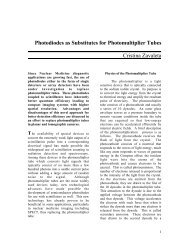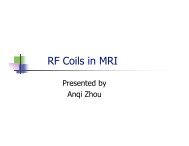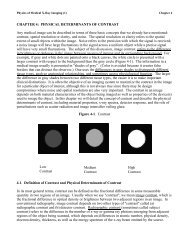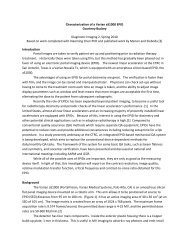In Vivo MR Measurements of Regional Arterial and Venous Blood ...
In Vivo MR Measurements of Regional Arterial and Venous Blood ...
In Vivo MR Measurements of Regional Arterial and Venous Blood ...
Create successful ePaper yourself
Turn your PDF publications into a flip-book with our unique Google optimized e-Paper software.
<strong>In</strong> <strong>Vivo</strong> <strong>MR</strong> <strong>Measurements</strong> <strong>of</strong> <strong>Regional</strong> <strong>Arterial</strong> <strong>and</strong><br />
<strong>Venous</strong> <strong>Blood</strong> Volume Fractions in <strong>In</strong>tact Rat Brain<br />
Timothy Q. Duong <strong>and</strong> Seong-Gi Kim*<br />
<strong>In</strong> vivo measurement <strong>of</strong> cerebral arterial <strong>and</strong> venous volume<br />
fractions is important to the underst<strong>and</strong>ing <strong>of</strong> brain physiology<br />
<strong>and</strong> function. By using an intravascular perfluorocarbon <strong>and</strong> 19 F<br />
N<strong>MR</strong> at 4.7 T, regional arterial <strong>and</strong> venous volume fractions<br />
from an intact rat brain were resolved based on the pseudodiffusion<br />
coefficients, which were (33 7) 10 -3 <strong>and</strong> (0.45 <br />
0.13) 10 -3 mm 2 /sec (mean SD, n 7) for the fast- <strong>and</strong><br />
slow-moving component, respectively. By exploiting the linear<br />
dependence <strong>of</strong> the perfluorocarbon 19 F 1/T1 on the dissolved<br />
paramagnetic oxygen concentration, combined inversion-recovery<br />
<strong>and</strong> diffusion measurements were made to correlate the<br />
short T1 (high-oxygenation) component with the fast-moving<br />
component <strong>and</strong> the long T1 (low-oxygenation) component with<br />
the slow-moving component. The arterial blood volume fraction<br />
was 29 7% <strong>of</strong> the total cerebral blood volume. Finally, experiments<br />
were performed in which different oxygen concentrations<br />
were inhaled to validate this technique. Magn Reson<br />
Med 43:393–402, 2000. © 2000 Wiley-Liss, <strong>In</strong>c.<br />
19<br />
Key words: perfluorocarbon; oxygen tension; F N<strong>MR</strong>;<br />
pseudodiffusion; CBV; BOLD; IVIM<br />
The ability to measure regional arterial <strong>and</strong> venous blood<br />
volume in an intact brain noninvasively has many potential<br />
biomedical applications. <strong>Arterial</strong> <strong>and</strong> venous blood<br />
volumes are important indicators <strong>of</strong> brain tissue physiology,<br />
viability <strong>and</strong> function. These physiological parameters<br />
are carefully regulated under normal conditions. They<br />
may change in response to increased neuronal activity <strong>and</strong><br />
can be drastically perturbed in diseased states such as<br />
cerebral ischemia, tumor or edema. Measurement <strong>of</strong> the<br />
cerebral arterial/venous blood volume fractions in a serial<br />
<strong>and</strong> relatively noninvasive manner may prove useful for<br />
evaluating cerebral function <strong>and</strong> pathology in which these<br />
physiological parameters are functionally or pathologically<br />
altered.<br />
<strong>In</strong> a technique generally referred to as intravoxel incoherent<br />
motion (IVIM) (1,2), an ensemble <strong>of</strong> spins moving<br />
in a r<strong>and</strong>om network <strong>of</strong> small blood vessels will give rise<br />
to a diffusion-weighted signal attenuation (1,2). Such a<br />
process is referred to as pseudodiffusion to distinguish it<br />
from pure diffusion. By using an intravascular perfluorocarbon,<br />
Neil <strong>and</strong> Ackerman (3) demonstrated that the diffusion-weighted<br />
19 F intravascular signal in brain was biexponential.<br />
They reported the pseudodiffusion coefficient<br />
(PDC) <strong>of</strong> the fast-moving components to be 80 times that<br />
Center for Magnetic Resonance Research, Department <strong>of</strong> Radiology, University<br />
<strong>of</strong> Minnesota School <strong>of</strong> Medicine, Minneapolis, Minnesota.<br />
Grant sponsor: National <strong>In</strong>stitutes <strong>of</strong> Health; Grant numbers: RR08079;<br />
NS38295; NS10930; Grant sponsor: the Whitaker Foundation.<br />
*Correspondence to: Seong-Gi Kim, Ph.D., Center for Magnetic Resonance<br />
Research, University <strong>of</strong> Minnesota School <strong>of</strong> Medicine, Radiology, 2021 Sixth<br />
Street SE, Minneapolis, MN 55455. E-mail: kim@cmrr.umn.edu<br />
Received 7 July 1999; revised 8 November 1999; accepted 11 November<br />
1999.<br />
© 2000 Wiley-Liss, <strong>In</strong>c. 393<br />
<strong>of</strong> the slow-moving component. However, according to the<br />
authors, “it was not clear what the two components represented”<br />
(3). It has been proposed that this biexponential<br />
characteristic was the result <strong>of</strong> the continuous distribution<br />
<strong>of</strong> blood velocities <strong>and</strong> vessel sizes (4). Henkelman et al.<br />
(4) employed a model <strong>of</strong> hierarchical, self-similar network<br />
<strong>of</strong> blood vessels to model the 19 F perfluorocarbon diffusion-weighted<br />
data (3). However, the estimated perfusion<br />
in the rat brain was an order <strong>of</strong> magnitude lower than that<br />
reported in the literature.<br />
We were intrigued by the marked <strong>and</strong> distinct difference<br />
in magnitude between the two PDCs. We hypothesized<br />
that the larger PDC is predominantly associated with the<br />
fast-flowing arterial blood, whereas the smaller PDC is<br />
predominantly associated with the slow-flowing venous<br />
blood. To test this hypothesis, the oxygen-sensitive property<br />
<strong>of</strong> perfluorocarbon was used to determine whether the<br />
larger PDC predominantly originates from the more oxygenated<br />
arterial compartment <strong>and</strong> the smaller PDC from<br />
the less oxygenated venous compartment.<br />
Perfluorocarbon emulsions are known to be excellent<br />
blood substitutes <strong>and</strong> <strong>MR</strong> detectable (5,6). They do not<br />
cross the blood brain barrier (BBB) <strong>and</strong> thus serve as intravascular<br />
tracers in brain. The spin-lattice relaxation rate<br />
constant (R 1 1/T 1)<strong>of</strong>the 19 F nuclei <strong>of</strong> a perfluorocarbon<br />
is linearly dependent on the dissolved oxygen concentration<br />
(5,6). The paramagnetic molecular oxygen is the predominant<br />
source <strong>of</strong> T 1 relaxation in vivo. Thus, these<br />
unique PFC properties <strong>of</strong>fer a potentially valuable tool for<br />
identifying <strong>and</strong> measuring relative arterial <strong>and</strong> venous<br />
blood volume in the in vivo brain based on oxygenation<br />
differences.<br />
Combined 19 F inversion-recovery <strong>and</strong> pseudodiffusion<br />
measurements were made in intact rat brain following the<br />
intravenous infusion <strong>of</strong> a perfluorocarbon to test the above<br />
hypothesis. Further, experiments were also performed in<br />
which the oxygen concentration <strong>of</strong> the inhaled gas was<br />
modulated to validate this technique. To the best <strong>of</strong> our<br />
knowledge, this study presents the first in vivo <strong>MR</strong> measurement<br />
<strong>of</strong> regional arterial/venous blood volume fractions<br />
<strong>and</strong> their relative oxygen tension changes in the<br />
intact rat brain. This technique can provide a means by<br />
which to evaluate these physiological parameters serially<br />
<strong>and</strong> in a relatively noninvasive manner in situ <strong>and</strong> in vivo.<br />
Further, the results <strong>of</strong> this study also have important implications<br />
on the blood oxygenation level dependent<br />
(BOLD) functional <strong>MR</strong>I measurements.<br />
THEORY<br />
Magnetic Resonance in Medicine 43:393–402 (2000)<br />
Oxygen-sensitive perfluorocarbon emulsion in general<br />
does not cross the blood brain barrier to exchange with the<br />
extravascular pool when administered intravenously (3).
394 Duong <strong>and</strong> Kim<br />
Relevant to the study herein, we model the cerebral vasculature<br />
as a nonexchanging, two-compartment model;<br />
namely, the arterial <strong>and</strong> venous pools. The arterial <strong>and</strong><br />
venous compartments, which constitute primarily <strong>of</strong> small<br />
arterioles <strong>and</strong> venules, are defined as the compartments<br />
that do not undergo oxygen exchange with the brain tissue.<br />
The capillary volume, which undergoes oxygen exchange<br />
with tissue, is small (7) <strong>and</strong>/or is assumed to correspondingly<br />
factor into its arterial <strong>and</strong> venous constituents.<br />
According to the IVIM model (1,2), the two nonexchanging<br />
arterial <strong>and</strong> venous pools <strong>of</strong> r<strong>and</strong>omly oriented vessels<br />
can be characterized by two PDCs (D*). The diffusionweighted<br />
signal attenuation can be written as<br />
S i/S 0f aexpb iD* a1f aexpb iD* b, [1]<br />
where S i is the signal amplitude at b i <strong>and</strong> S o is the signal<br />
amplitude at b 0. f a is the fraction (or percent if multiplied<br />
by 100) <strong>of</strong> spins with the larger pseudodiffusion<br />
coefficient, D* a (the fast-moving component). The remainder<br />
<strong>of</strong> the spins have a smaller pseudodiffusion coefficient,<br />
D* b (the slow-moving component). The parameter b i is<br />
given by<br />
b i 2 G i 2 2 3 [2]<br />
where is the magnetogyric ratio, G i is the gradient<br />
strength, is the duration <strong>of</strong> each gradient pulse, <strong>and</strong> is<br />
the time between the application <strong>of</strong> the two gradient<br />
pulses. (/3) is also known as the diffusion time (t diff)<br />
during which the diffusion measurement is sensitive to<br />
motion.<br />
Similarly, in principle, the difference in oxygenation<br />
between the two nonexchanging vascular pools can give<br />
rise to two relaxation time constants (T 1). The inversion<br />
recovery (IR) signal behavior can be written as<br />
STIexpTIT 11expTIT 1 [3]<br />
where S(TI) is the signal amplitude at an inversion time TI<br />
<strong>and</strong> is a constant; is the fraction (or percentage) <strong>of</strong><br />
spins with a shorter T 1 (T 1). The remainder <strong>of</strong> the spins<br />
have a longer T 1 (T 1). Note that the volume fraction in<br />
Eq. [3] <strong>and</strong> f a in Eq. [1] are not necessarily the same a<br />
priori.<br />
METHODS<br />
<strong>In</strong> Vitro Calibration<br />
Perfluoro–15–crown–5–ether (Exfluor Research Corp.,<br />
Round Rock, TX) is a highly sensitive perfluorocarbon<br />
with 20 equivalent 19 F nuclides, giving rise to one single<br />
resonance. High sensitivity is critical because <strong>of</strong> the small<br />
blood volume in the brain. The perfluorocarbon was emulsified<br />
into 200-nm diameter micelles (40% v/v, Gateway<br />
Technology <strong>In</strong>c., St. Louis, MO). <strong>In</strong> vitro calibration relating<br />
R1 to O2 was made using four different gas conditions<br />
(0, 21, 31, <strong>and</strong> 100% O2 with balance N2O) bubbled into a<br />
pure perfluorocarbon emulsion sample for 30–60 min to<br />
equilibrium at 37°C. Two different samples were prepared<br />
for each gas condition <strong>and</strong> two T1 measurements were<br />
made on each sample. The sample temperature was monitored<br />
<strong>and</strong> maintained at 37.0 0.5°C during the T 1 measurement.<br />
19 F IR measurements were made using 20 inversion<br />
delays (TI). Conversion <strong>of</strong> percent oxygen to mmHg<br />
assumed that 100% oxygen is equal to 760 mmHg. The free<br />
diffusion coefficient (D) in a phantom <strong>of</strong> pure perfluorocarbon<br />
emulsion at 37°C was measured using 10 b-values<br />
with the largest b-value <strong>of</strong> 40,000 sec/mm 2 .<br />
Animal Surgery<br />
Seven male Sprague Dawley rats (200–270 g) were anesthetized<br />
with 1% (v/v) halothane in O 2:N 2O gas mixture<br />
during surgery <strong>and</strong> throughout the experiments. Following<br />
oral intubation, a jugular vein, a femoral artery, <strong>and</strong> a<br />
femoral vein were catheterized for physiological monitoring,<br />
blood gas sampling, <strong>and</strong> chemical administration. For<br />
a better representation <strong>of</strong> the cerebral venous blood oxygenation,<br />
blood gas was sampled via the jugular vein instead<br />
<strong>of</strong> the femoral vein. <strong>Arterial</strong> blood gas was sampled<br />
frequently to ensure a steady state <strong>of</strong> arterial pO 2 <strong>and</strong><br />
pCO 2. A capnometer was also employed to monitor the<br />
inspired O 2/N 2O <strong>and</strong> the expired CO 2 <strong>of</strong> the animals. Heart<br />
rate <strong>and</strong> blood pressure were measured via the femoral<br />
artery by using a pressure transducer <strong>and</strong> a differential<br />
amplifier (Acknowledge, Biopac, Santa Barbara, CA). The<br />
animal’s rectal temperature was monitored <strong>and</strong> maintained<br />
at 371° C. While the animal was in the magnet, the<br />
pH-balanced, isotonic perfluorocarbon emulsion was administered<br />
intravenously (16 ml/kg), while a roughly<br />
equal volume <strong>of</strong> blood was simultaneously withdrawn<br />
from the femoral artery over 1 min.<br />
<strong>In</strong> four <strong>of</strong> the seven rats, oxygen concentration <strong>of</strong> the<br />
inhaled gas was modulated without changing the arterial<br />
blood gas pCO 2 during the experiment. Two to six different<br />
oxygen concentrations were used. It had been shown<br />
that hyperoxia does not significantly alter cerebral blood<br />
flow (CBF) <strong>and</strong> metabolism if a constant arterial pCO 2 is<br />
maintained (8).<br />
<strong>MR</strong> Experiments<br />
All <strong>MR</strong> experiments were performed on a 4.7-T, 40-cm<br />
horizontal <strong>MR</strong>I scanner (Oxford Magnet, Oxford, UK)<br />
equipped with a Unity INOVA console (Varian, Palo Alto,<br />
CA), <strong>and</strong> a homebuilt gradient set (15-G/cm, 150-sec<br />
risetime for all three axes). The same gradient set was used<br />
for imaging/voxel selection <strong>and</strong> diffusion measurements.<br />
The animal was carefully secured in a head-holder with<br />
ear <strong>and</strong> bite bars after surgery. A surface coil (1.2 cm in<br />
diameter) was positioned on top <strong>of</strong> the rat head. An imageguided<br />
voxel <strong>of</strong> 8 10 8mm 3 was placed at the center<br />
<strong>of</strong> the brain with minimal or no extracerebral <strong>and</strong> superficial<br />
surface vessel signal contamination. Magnetic field<br />
homogeneity was optimized in the voxel by 1 H 2O shimming<br />
to yield 12–18 Hz spectral linewidth. All 19 F<strong>MR</strong><br />
spectra were acquired using the volume-localized, double<br />
spin-echo point-resolved spectroscopy (PRESS) sequence.<br />
The three radi<strong>of</strong>requency pulses in the PRESS sequence<br />
were 3-msec sinc pulses. A pair <strong>of</strong> crusher gradients (10<br />
G/cm for 3 msec) were placed around each <strong>of</strong> the two 180°<br />
refocusing pulses to destroy residual transverse magneti-
Cerebral <strong>Arterial</strong> <strong>and</strong> <strong>Venous</strong> <strong>Blood</strong> Volume 395<br />
zation. The 19 F IR curve was sampled using logarithmically<br />
spaced TIs with 5 T 1 between inversion pulses<br />
(10-msec sinc pulse).<br />
Biexponential T1 <strong>and</strong> D* <strong>Measurements</strong><br />
19<br />
FT1measurements on a single voxel were made using 64<br />
logarithmically spaced TIs. Four to eight transients were<br />
accumulated for signal averaging, yielding a total temporal<br />
resolution <strong>of</strong> 30–60 min. 19 F pseudodiffusion measurements<br />
were made using the modified PRESS sequence to<br />
include the Stejskal-Tanner diffusion measurement<br />
scheme (9). A pair <strong>of</strong> diffusion gradients were placed<br />
around each <strong>of</strong> the two 180° refocusing pulses <strong>and</strong> the<br />
diffusion gradients were turned on in all three principal<br />
axes simultaneously, resulting in a total <strong>of</strong> 6 pairs <strong>of</strong> diffusion<br />
gradients. The sequence parameters were: TE 42<br />
msec, 10.6 msec, 6 msec, tdiff 8.6 msec, b 1,<br />
14, 25, 46, 78, 162, 522, <strong>and</strong> 1032 sec/mm 2 (see Eq. [2] for<br />
definitions). The b-values also included corrections for<br />
diffusion-weighting contributions from crusher gradients,<br />
voxel selection gradients <strong>and</strong> cross-gradient interaction<br />
(10) among diffusion, voxel selection, <strong>and</strong> crusher gradients<br />
as described elsewhere (9). Four to eight transients<br />
were accumulated for signal averaging, yielding a temporal<br />
resolution <strong>of</strong> 15–30 min.<br />
<strong>In</strong> <strong>Vivo</strong> Correlation <strong>of</strong> T1 Values <strong>and</strong> PDCs<br />
Combined IR <strong>and</strong> diffusion measurements were made to<br />
correlate the T1 components with the PDCs by selective<br />
signal nulling. Thirty-two logarithmically spaced TI values,<br />
up to 5 T1, were used to search for the signal nulls.<br />
Following each <strong>of</strong> the 32 TIs, diffusion measurements<br />
were made with seven b-values (1, 14, 25, 36, 212, 417, <strong>and</strong><br />
621 sec/mm 2 ). The null point <strong>of</strong> the slow-moving component<br />
was chosen as the TI value at which the echo amplitudes<br />
<strong>of</strong> the large b-values (212, 417, <strong>and</strong> 621 sec/mm 2 )<br />
were at the noise level. The null point <strong>of</strong> the fast-moving<br />
component was chosen as the TI value at which the echo<br />
amplitudes <strong>of</strong> the small b-values (b 1, 14, 25, <strong>and</strong> 36<br />
sec/mm 2 ) were the same as that <strong>of</strong> the first large b-value<br />
(212 sec/mm 2 ). Two to four transients were accumulated<br />
for signal averaging, yielding a temporal resolution <strong>of</strong> 20<br />
min. At each inversion delay, the PDCs <strong>and</strong> fa values were<br />
determined by using Eq. [1].<br />
After determining roughly the two TI values at which<br />
the signal nulls occurred using the 32 inversion delays, a<br />
further search was made by using more densely sampled<br />
points (8–15 TI values) around the roughly determined<br />
null points. The series <strong>of</strong> TI values were typically set in<br />
steps <strong>of</strong> 0.05 sec. Four to eight transients were accumulated<br />
for signal averaging, resulting in a temporal resolution<br />
<strong>of</strong> 10–15 min. Typically, 4–6 selective nulling experiments<br />
with the high sampling density were performed on<br />
each animal. The PDCs <strong>and</strong> fa values were determined <strong>and</strong><br />
averaged for further analysis.<br />
Data Analysis<br />
<strong>In</strong>version recovery data were fitted using the nonlinear<br />
least-square method <strong>and</strong>/or the Bayesian probability theory<br />
method (9,11). The diffusion data were plotted as<br />
FIG. 1. <strong>In</strong> vitro st<strong>and</strong>ard calibration curve <strong>of</strong> R 1 at 37°C versus<br />
percent dissolved O 2 at four different gas concentrations <strong>of</strong> 0, 21,<br />
31, <strong>and</strong> 100% O 2 with balance N 2O. The linear least-squares analysis<br />
yielded R 1 0.362 0.0163 O 2,R 2 0.999. The error bars<br />
indicate the st<strong>and</strong>ard deviations (which may be smaller than the<br />
data points <strong>and</strong> thus not visible). The * symbols represent measurements<br />
made on the withdrawn arterial blood samples obtained from<br />
a rat inhaling three different N 2O:O 2 gas mixture after blood/perfluorocarbon<br />
exchange. Only the data points from the pure perfluorocarbon<br />
emulsions (not the blood samples) were included in the<br />
linear least-squares fit.<br />
Stejskal-Tanner semilog plots (Eq. [1]) <strong>and</strong> fitted using the<br />
nonlinear least-squares method (ORIGIN 5.0 from Microcal,<br />
Northampton, MA). Statistical analysis employed the<br />
Student paired t-test <strong>and</strong> a p-value <strong>of</strong> 0.05 was generally<br />
taken as the criterion for statistical significance unless<br />
otherwise specified. All reported values are in means <br />
st<strong>and</strong>ard deviations.<br />
RESULTS<br />
<strong>In</strong> Vitro <strong>Measurements</strong><br />
The st<strong>and</strong>ard calibration curve for perfluorocarbon 19 FR1 versus percent dissolved oxygen at 37°C is shown in Fig. 1.<br />
From linear least-squares analysis<br />
R 10.3620.0163 O 2,R 2 0.999 [4]<br />
where O 2 is the percent oxygen bubbled into the solution.<br />
<strong>In</strong> addition, three arterial blood samples were withdrawn<br />
from a perfluorocarbon-infused rat after sequentially inhaling<br />
three different O 2 concentrations. The perfluorocarbon<br />
19 FT 1 <strong>of</strong> the air-sealed blood samples were measured<br />
at 37°C. <strong>Blood</strong> gas pO 2 was obtained immediately at the<br />
end <strong>of</strong> each T 1 measurement. These results, consistent<br />
with the calibration curve using the pure perfluorocarbon<br />
emulsion, are plotted as * symbols in Fig. 1.<br />
<strong>In</strong> vitro diffusion measurements <strong>of</strong> the perfluorocarbon<br />
emulsion in a phantom at 37°C showed only minor signal<br />
attenuation with the largest b-value <strong>of</strong> 40,000 sec/mm 2<br />
(data not shown). The free diffusion coefficient D <strong>of</strong> the
396 Duong <strong>and</strong> Kim<br />
FIG. 2. a: Representative series <strong>of</strong> 19 F diffusion-weighted, volume-localized N<strong>MR</strong> spectra from a live animal. The full-width-at-halfmaximum<br />
(FWHM) <strong>of</strong> each spectrum was 30 Hz. A line broadening <strong>of</strong> 30 Hz was used. The scale bar indicates the frequency scale <strong>of</strong> 1<br />
ppm. The number below each spectrum represents the b-value (in sec/mm 2 ) at which the spectrum was obtained. b: The semilog<br />
Stejskal-Tanner diffusion plot <strong>of</strong> S/S o versus b-value. Filled circles represent data from a live animal, <strong>and</strong> open circles represent data from<br />
the same animal postmortem. The solid lines are the nonlinear least-squares fits to the data. For the live animal, the biexponential curve<br />
fitting gave values <strong>of</strong> D* a 20 10 3 mm 2 /sec, D* b 0.5 10 3 mm 2 /sec, <strong>and</strong> f a 27%. The data points from the dead animal show<br />
virtually no signal attenuation at the b-values employed. The estimated D* postmortem from the monoexponential fitting is on the order <strong>of</strong><br />
0.001 10 3 mm 2 /sec.<br />
perfluorocarbon emulsion at 37°C was estimated to be <br />
0.001 10 3 mm 2 /sec.<br />
<strong>In</strong> <strong>Vivo</strong> PDC <strong>and</strong> T1 <strong>Measurements</strong><br />
Following the blood/perfluorocarbon exchange up to 6<br />
hr, arterial blood gas, mean arterial blood pressure, <strong>and</strong><br />
heart rate <strong>of</strong> the animal did not differ significantly from<br />
normal values. Following the blood/perfluorocarbon exchange<br />
<strong>and</strong> multiple blood gas sampling, blood hematocrit<br />
measurements (from which perfluorocarbon, red blood<br />
cells <strong>and</strong> plasma were clearly distinguishable) showed<br />
that the blood hematocrit decreased only slightly from a<br />
normal value <strong>of</strong> 45% to 37% (n 2) toward the end<br />
<strong>of</strong> the experiments.<br />
Following the blood/perfluorocarbon exchange in the<br />
animal, 19 F PDCs were measured. Figure 2a shows a representative<br />
series <strong>of</strong> 19 F diffusion-weighted, volume-localized<br />
spectra from a live animal. The corresponding semilog<br />
Stejskal-Tanner diffusion plot <strong>of</strong> the spectra (• symbol)<br />
is shown in Fig. 2b. The diffusion-weighted signal decay<br />
was clearly not monoexponential. The data set was best fit<br />
by a biexponential function. The PDCs were D* a 20 <br />
10 3 mm 2 /sec <strong>and</strong> D* b 0.5 10 3 mm 2 /sec with the<br />
volume fraction <strong>of</strong> component a, fa 27%. On the other<br />
h<strong>and</strong>, diffusion-weighted signal attenuation from a dead<br />
animal was negligible with the given b-values (Fig. 2b).<br />
The estimated PDC postmortem was on the order <strong>of</strong> <br />
0.001 10 3 mm 2 /sec.<br />
<strong>In</strong> vivo 19 FT1 measurements were made to determine<br />
whether the arterial <strong>and</strong> venous blood can be resolved<br />
based on T1 differences. A representative inversion recovery<br />
curve from a live animal is shown in Fig. 3. The data<br />
were best fitted by a biexponential model. The estimated<br />
parameters were T1 0.16 sec, T1 0.78 sec, <strong>and</strong> <br />
13%. Based on these in vivo T 1 values, the arterial <strong>and</strong><br />
venous oxygen tensions estimated via the calibration<br />
curve (Eq. [4]) were inconsistent with those obtained via<br />
blood gas sampling <strong>of</strong> 231 <strong>and</strong> 64 mmHg, respectively.<br />
This discrepancy indicated that the in vivo T 1 values were<br />
underestimated due to the inflow effect (which effectively<br />
FIG. 3. A representative inversion-recovery curve obtained from a<br />
volume-localized voxel. The data are represented in filled circles.<br />
The solid line is the fit to a single exponential function. Note the<br />
overshoot/undershoot <strong>of</strong> the fit, which indicates the presence <strong>of</strong> at<br />
least one more exponential component in the data set. The dashed<br />
line is the fit to a biexponential function for which excellent correspondence<br />
between data <strong>and</strong> model is observed. Bayesian probability<br />
theory estimated the probability for two exponentials in the<br />
data set to be 0.999. The estimated parameters were T 1 0.16 s,<br />
T 1 0.78 s, <strong>and</strong> 13%.
Cerebral <strong>Arterial</strong> <strong>and</strong> <strong>Venous</strong> <strong>Blood</strong> Volume 397<br />
FIG. 4 a: Diffusion-weighted spectra obtained with seven b-values for three different inversion delays. The scale bar indicates the frequency<br />
scale <strong>of</strong> 1 ppm. The number below each spectrum represents the b-value (in sec/mm 2 ) at which the spectrum was obtained. The notations<br />
1x, 8x <strong>and</strong> 64x on the right <strong>of</strong> the spectra indicate the vertical scaling factors. (i) Diffusion-weighted spectra for TI 0.49 s at which one<br />
PDC component was nulled. The signal intensities obtained with the larger b-values <strong>of</strong> 212, 417 <strong>and</strong> 621 sec/mm 2 are almost at the noise<br />
levels. The larger PDC can be determined. (ii) Diffusion-weighted spectra for TI 0.28 s at which the other PDC component is nulled. The<br />
signal intensities obtained with the smaller b-values <strong>of</strong> 1, 14, 25 <strong>and</strong> 36 sec/mm 2 are roughly equal to that obtained with b 212 s/mm 2<br />
(the first large b-value). The smaller PDC can be determined. (iii) Diffusion-weighted spectra at TI 5 T 1. The signal decay is the weighted<br />
average <strong>of</strong> the “fast” <strong>and</strong> “slow” pseudodiffusion coefficients. b: The corresponding Stejskal-Tanner semilog plots for the spectra shown<br />
in Fig. 4a. The first points <strong>of</strong> all three Stejskal-Tanner plots were normalized to unity for consistency in presentation. The selective nulling<br />
<strong>of</strong> each <strong>of</strong> the two components was efficient, typically left with 5% residuals.<br />
shortened the measured T 1 values). Following the death <strong>of</strong><br />
the animal, the inversion recovery data set was best fit by<br />
a monoexponential function (data not shown), yielding a<br />
postmortem T 1 <strong>of</strong> 2.80 sec. The averaged 19 FT 1 postmortem<br />
from all seven animals was 2.85 0.15 sec, consistent<br />
with the in vitro T 1 value at 0% oxygen concentration <strong>of</strong><br />
2.76 sec.<br />
<strong>In</strong> <strong>Vivo</strong> Correlation <strong>of</strong> T1 Values <strong>and</strong> PDCs<br />
Combined IR <strong>and</strong> diffusion measurements were employed<br />
to determine whether the D* a <strong>and</strong> D* b were predominantly<br />
associated with T1 (more oxygenated arterial component)<br />
<strong>and</strong> T1 (less oxygenated venous component), respectively.<br />
This was done by selectively nulling the signal<br />
contribution from one T1 component while measuring the<br />
PDC <strong>of</strong> the other component. Figure 4a (i) shows the diffusion-weighted<br />
spectra at TI 0.49 sec at which one PDC<br />
component was nulled. The signal intensities at high bvalues<br />
(212, 417, 621 sec/mm 2 ) were essentially zero (i.e.,<br />
into the noise level). Consequently, the spins <strong>of</strong> the slowmoving<br />
component did not contribute to the signal intensities<br />
at low b-values (1, 14, 25, 36 sec/mm 2 ). The fastmoving<br />
PDC, D* a, was determined to be 45 10 3 mm 2 /<br />
sec. Similarly, Fig. 4a (ii) shows the diffusion-weighted<br />
spectra at TI 0.28 sec at which the other PDC component<br />
was nulled. The signal intensities at low b-values (1, 14,<br />
25, 36 sec/mm 2 ) have similar magnitude as the intensity at<br />
b 212 sec/mm 2 (the first <strong>of</strong> the high b-value). Consequently,<br />
the spins <strong>of</strong> the fast-moving component did not<br />
contribute to the signal intensities at high b-values (212,<br />
417, 621 sec/mm 2 ). The slow-moving PDC, D* b, was determined<br />
to be 0.35 10 3 mm 2 /sec. Based on the two sets<br />
<strong>of</strong> spectra, the fast-moving D* a was identified as having a<br />
shorter T 1 (T 1 0.41) <strong>and</strong> the slow-moving D* b was<br />
identified as having a longer T 1 (T 1 0.71).<br />
As a reference, Fig. 4a (iii) shows the diffusion-weighted<br />
spectra at TI 5 T 1. The diffusion-weighted signal attenuation<br />
is a weighted average <strong>of</strong> the fast- <strong>and</strong> slow-moving<br />
components. Biexponential fitting <strong>of</strong> the diffusion data to<br />
Eq. [1] yielded D* a 45 10 3 mm 2 /sec, D* b 0.5 <br />
10 3 mm 2 /sec, <strong>and</strong> f a 25%. These PDCs (obtained via<br />
biexponential PDC fitting) were consistent with those obtained<br />
via the selective nulling (Fig. 4a, i <strong>and</strong> ii).<br />
For better visualization, the diffusion-weighted spectra<br />
in Fig 4a are plotted as Stejskal-Tanner semilog plots.<br />
These are shown in Fig. 4b. The first points <strong>of</strong> all three<br />
Stejskal-Tanner plots were normalized to unity for consistency.<br />
The selective nulling <strong>of</strong> each <strong>of</strong> the two components<br />
was efficient, typically left with 5% residuals. The small<br />
residuals also suggested the absence <strong>of</strong> additional PDC<br />
components.<br />
Table 1 summarizes the average results <strong>of</strong> the combined<br />
IR <strong>and</strong> diffusion measurements for all animals. The average<br />
D* a <strong>and</strong> D* b were (33.3 7.4) 10 3 mm 2 /sec <strong>and</strong><br />
(0.45 0.13) 10 3 mm 2 /sec, respectively, as obtained by<br />
using the nulling technique. The average D* a <strong>and</strong> D* b were<br />
(34.8 9.3) 10 3 mm 2 /sec <strong>and</strong> (0.52 0.13) 10 3<br />
mm 2 /sec, respectively, as obtained by using the biexponential<br />
fitting <strong>of</strong> the diffusion data at TI 5 T 1. There<br />
were no statistical differences between the PDCs determined<br />
via the two methods. The average D* a was about 80<br />
times that <strong>of</strong> D* b <strong>and</strong> they were statistically different from<br />
each other (p 2 10 5 ). The average blood volume<br />
fraction <strong>of</strong> component a (f a) was 29 6% <strong>of</strong> the total<br />
cerebral blood volume.
398 Duong <strong>and</strong> Kim<br />
Table 1<br />
Summary <strong>of</strong> D* a,D* b <strong>and</strong> f a (Mean SD, n 7) a<br />
By nulling b<br />
Correlation <strong>of</strong> R 1a Versus <strong>Arterial</strong> pO 2<br />
<strong>In</strong> order to verify that the short T 1 component is indeed<br />
sensitive to changes in arterial oxygen tension, combined<br />
IR <strong>and</strong> diffusion experiments were performed in which the<br />
oxygen concentration <strong>of</strong> the inhaled gas was modulated<br />
without changing the arterial blood gas pCO 2. The arterial<br />
blood gas pCO 2 was maintained at 32 5 mmHg (ranging<br />
from 24 to 38 mmHg for all four animals). Figure 5 shows<br />
a representative single-animal plot <strong>of</strong> R 1 <strong>of</strong> the fast-moving<br />
component (R 1a) versus arterial blood gas pO 2. There is<br />
D* a (10 3 mm 2 /sec) D* b (10 3 mm 2 /sec)<br />
By fitting c<br />
By nulling b<br />
By fitting c<br />
Rat 1 34.0 30.0 0.47 0.55 36.6<br />
Rat 2 35.0 40.0 0.55 0.65 28.1<br />
Rat 3 39.0 50.0 0.67 0.53 28.6<br />
Rat 4 24.0 27.0 0.29 0.34 17.3<br />
Rat 5 41.0 36.0 0.35 0.52 36.0<br />
Rat 6 38.0 38.5 0.48 0.68 28.5<br />
Rat 7 22.0 22.0 0.34 0.36 31.0<br />
Mean 33.3 e<br />
34.8 e<br />
0.45 e<br />
0.52 e<br />
29.4<br />
SD 7.4 9.3 0.13 0.13 6.4<br />
a<br />
The average value <strong>of</strong> each animal was obtained by first averaging the 4–6 measurements for each arterial pO2, <strong>and</strong> then averaging across<br />
multiple arterial pO2 (if applicable). No correlation between the PDC <strong>and</strong> arterial pO2 was observed. The average blood gas pCO2 across<br />
different inhaled [O2] was at 32 5 mmHg.<br />
b<br />
D* a <strong>and</strong> D* b were determined by nulling each <strong>of</strong> the two components one at a time.<br />
c<br />
D* a <strong>and</strong> D* b were determined by fitting <strong>of</strong> the diffusion data at TI 5 T1. d<br />
fa was determined via biexponential fitting <strong>of</strong> the diffusion data at TI 5 T1. e<br />
D* a values measured by nulling <strong>and</strong> by fitting were not statistically different from each other (p 0.15). D* b values measured by nulling <strong>and</strong><br />
by fitting were also not statistically different from each other (p 0.50). D* a <strong>and</strong> D* b were statistically different from each other (p 2 10 5 ).<br />
Thus, measurements <strong>of</strong> PDCs <strong>and</strong> arterial/venous blood volume fractions can be done by performing diffusion measurements at TR 5 <br />
T1 followed by biexponential PDC fitting (this is the most time efficient scheme).<br />
FIG. 5. <strong>In</strong> vivo perfluorocarbon R 1 <strong>of</strong> the fast-moving component<br />
(R 1a) versus arterial oxygen tension. The R 1a was determined from<br />
the selective nulling <strong>MR</strong> experiments <strong>and</strong> the arterial oxygen tension<br />
was measured via blood gas sampling. The relationship <strong>of</strong> the in<br />
vivo R 1a versus arterial blood gas pO 2 (expressed as % O 2 instead<br />
<strong>of</strong> mmHg) is R 1a 1.7 0.015 O 2,R 2 0.94. The slope is similar<br />
to that <strong>of</strong> the in vitro calibration curve (0.016).<br />
f a (%) d<br />
clearly a positive linear correlation between R 1a <strong>and</strong> arterial<br />
pO 2 (R 1a 1.7 0.015 O 2,R 2 0.94). The slope <strong>of</strong><br />
0.015 is consistent with that (0.016) <strong>of</strong> the calibration<br />
curve (Fig. 1). The intercept <strong>of</strong> this plot, on the other h<strong>and</strong>,<br />
differs from that <strong>of</strong> the calibration curve, consistent with<br />
the notion that the inflow contributed significantly to the<br />
measured T 1 value. Table 2 summarizes the slopes <strong>and</strong><br />
intercepts from the four animals in which the O 2 content<br />
<strong>of</strong> the inhaled gas was modulated. The average slope <strong>and</strong><br />
intercept were 0.014 0.005 <strong>and</strong> 2.6 0.7, respectively.<br />
Little or no correlation between the R 1 <strong>of</strong> the slowmoving<br />
component (R 1b) <strong>and</strong> arterial blood gas pO 2 was<br />
observed, consistent with the arterial <strong>and</strong> venous blood<br />
gas measurements. This is because the venous blood gas<br />
pO 2 changed over a very small range as the arterial blood<br />
gas pO 2 was modulated (a direct consequence <strong>of</strong> the oxygen-binding<br />
characteristics <strong>of</strong> hemoglobin). No correlation<br />
between R 1a <strong>and</strong> venous blood gas pO 2 was observed.<br />
Similarly, no correlation between R 1b <strong>and</strong> venous blood<br />
gas pO 2 was observed.<br />
DISCUSSION<br />
Biocompatibility <strong>of</strong> Perfluorocarbon<br />
Biocompatibility <strong>of</strong> perfluorocarbon emulsions as blood<br />
substitutes have been extensively reviewed (5,12). Some<br />
perfluorocarbons have been approved for human use <strong>and</strong><br />
still many others are under clinical trials (6). Following<br />
substantial ( 50%) blood volume replacement with various<br />
perfluorocarbon emulsions, animals are able to survive<br />
<strong>and</strong> develop normally (5). Specifically, perfluoro–15–<br />
crown–5–ether emulsion has been previously used to<br />
measure pO2 in mice with tumors <strong>and</strong> no ill effect was<br />
observed (13). Here we found no significant changes in the<br />
monitored physiological parameters for up to 6 hours<br />
following the exchange <strong>of</strong> blood with perfluoro–15–<br />
crown–5–ether emulsion in rats. The perfluorocarbon/
Cerebral <strong>Arterial</strong> <strong>and</strong> <strong>Venous</strong> <strong>Blood</strong> Volume 399<br />
Table 2<br />
Slopes <strong>and</strong> <strong>In</strong>tercepts <strong>of</strong> <strong>In</strong> <strong>Vivo</strong> R1a Versus <strong>Arterial</strong> <strong>Blood</strong>-Gas pO2 Plot<br />
Rat 1 Rat 2 Rat 3 Rat 4 Mean SD<br />
Slope 0.015 0.007 0.014 0.019 0.014 0.005 a<br />
<strong>In</strong>tercept 1.7 2.4 3.2 3.2 2.6 0.7 a<br />
a<br />
The average slope <strong>of</strong> 0.014 is consistent with that obtained from the calibration curve (0.0163). The average intercept <strong>of</strong> 2.6, on the other<br />
h<strong>and</strong>, differs from that <strong>of</strong> the calibration curve (0.362). This difference was attributed to the inflow effect (see text).<br />
blood exchange followed by multiple blood samplings decreased<br />
hematocrit, resulting in low oxygen delivery efficiency<br />
to the tissue. Consequently, the arterial blood gas<br />
pO 2 had to be maintained at 120 mmHg to prevent tissue<br />
hypoxia <strong>and</strong> death. We verified that such a need to maintain<br />
arterial pO 2 120 mmHg was largely not due to<br />
perfluorocarbon emulsion per se by performing experiments<br />
in which roughly equal amounts <strong>of</strong> blood was replaced<br />
by saline followed by multiple blood sampling (n <br />
3; data not shown). <strong>In</strong> these experiments, the animals did<br />
not survive if the arterial pO 2 was below 120 mmHg. <strong>In</strong><br />
short, the infusion <strong>of</strong> 15–crown–5–ether emulsion per se<br />
with the dose herein did not significantly perturb normal<br />
physiology.<br />
Pseudodiffusion Coefficients in Live Animals Are<br />
Dominated by Flow<br />
The free diffusion coefficient D <strong>of</strong> the pure perfluorocarbon<br />
emulsion in a phantom was estimated to be 0.001 <br />
10 3 mm 2 /sec at 37°C, approximately 10 3 times less than<br />
that <strong>of</strong> water (Dwater 3 10 3 mm 2 /sec at 37°C). This is<br />
consistent with the differences in size <strong>and</strong> viscosity between<br />
the perfluorocarbon emulsion particles <strong>and</strong> water<br />
molecules based on the Stoke-Einstein equation. The D* a<br />
<strong>and</strong> D* b in the live animal were at least two orders <strong>of</strong><br />
magnitude larger than the D* in the dead animal, indicating<br />
that the PDCs in the live animal were predominantly<br />
attributed to flow. <strong>In</strong> this aspect, perfluorocarbon dynamics<br />
is a reasonably good representation <strong>of</strong> water dynamics<br />
in the vasculature <strong>of</strong> a live animal. Therefore, perfluorocarbon<br />
can be used as a marker to mimic intravascular<br />
water motion (in the absence <strong>of</strong> vascular tissue water exchange).<br />
Biexponential Diffusion-Weighted Signal Attenuation<br />
A clear biexponential diffusion-weighted signal decay was<br />
observed. The T1 values obtained via the selective nulling<br />
method were clearly correlated with the T1 values obtained<br />
via the biexponential T1 fitting. Further, the PDCs<br />
obtained via the selective nulling method were essentially<br />
identical to those obtained via the biexponential fitting <strong>of</strong><br />
the diffusion data at TI 5 T1. These results strongly<br />
indicated that the larger PDC is predominantly associated<br />
with the more oxygenated arterial pool while the smaller<br />
PDC with the less oxygenated venous pool. D* a was approximately<br />
80 times that <strong>of</strong> D* b, corresponding to an<br />
average “pseudo” root–mean–squared (rms) displacement<br />
<strong>of</strong> a factor <strong>of</strong> 9. This does not appear to be unreasonable<br />
since arterial blood on average is known to be fasterflowing,<br />
pulsatile, <strong>and</strong> more turbulent (larger velocity-to-<br />
diameter ratio) relative to venous blood <strong>and</strong>, thus, arterial<br />
blood signals, arising from the r<strong>and</strong>om vascular network,<br />
are significantly more attenuated by diffusion gradients<br />
(14,15). <strong>In</strong>deed, biexponential behavior <strong>of</strong> the diffusionweighted<br />
signal had also been previously observed using a<br />
different perfluorocarbon (3). <strong>In</strong> a study using surface-coil<br />
localization on a rat brain <strong>and</strong> motion-sensitive gradient<br />
along the z–axis, Neil <strong>and</strong> Ackerman reported D* a <strong>and</strong> D* b<br />
to be 82.4 13 mm 2 /sec <strong>and</strong> 1.02 0.08 mm 2 /sec, respectively<br />
(3). The D* a was also 80 times that <strong>of</strong> D* b in their<br />
study even though both D* a <strong>and</strong> D* b <strong>of</strong> Neil <strong>and</strong> Ackerman<br />
were slightly larger than those reported here. Cross-laboratory<br />
consistency exists despite the PDCs were measured<br />
with motion-sensitive gradients along two different directions;<br />
namely, along an oblique axis herein <strong>and</strong> along the<br />
z–axis in their study. This comparison indicated that with<br />
sufficiently large voxels (i.e., entire rat brain) employed in<br />
both studies, the notion that the <strong>MR</strong> signals arose from a<br />
network <strong>of</strong> r<strong>and</strong>omly oriented vessels is well justified.<br />
The measured PDCs were not biased toward any large<br />
numbers <strong>of</strong> vessels orienting in any given direction. Therefore,<br />
the estimated arterial <strong>and</strong> venous blood volume fractions<br />
are unlikely to be significantly different from those<br />
estimated by measuring the PDCs in an orientationally<br />
averaged fashion.<br />
Henkelman et al. (4) postulated that the biexponential<br />
behavior <strong>of</strong> the PDCs is the result <strong>of</strong> the continuous hierarchical<br />
distribution <strong>of</strong> blood vessels (without arterial <strong>and</strong><br />
venous discrimination). Our data do not support the<br />
model <strong>of</strong> a hierarchical network <strong>of</strong> blood vessels as an<br />
explanation for the observed biexponential behavior <strong>of</strong> the<br />
vascular PFC in the brain. Further, the continuous distribution<br />
<strong>of</strong> vessel sizes in the hierarchical network fashion<br />
is unlikely to yield two readily resolvable T 1 as well as<br />
PDC components. Rather, a continuous distribution <strong>of</strong> the<br />
measured parameters would be expected. Our data suggested<br />
that the larger PDC was predominantly arterial in<br />
origin, while the smaller PDC was predominantly venous<br />
in origin. <strong>In</strong> all measurements, the fast-moving component<br />
correlated with a shorter T 1 (high-oxygenation arterial<br />
blood), while the slow-moving component correlated with<br />
a longer T 1 (low-oxygenation venous blood). We attributed<br />
these marked differences in PDCs to the differences in flow<br />
characteristics between the arterial <strong>and</strong> venous components,<br />
which gave rise to a difference in “pseudo” rms<br />
displacement <strong>of</strong> a factor <strong>of</strong> 9.<br />
Though the use <strong>of</strong> the simple two-compartment approach<br />
to model the cerebral vasculature yields valuable<br />
insight into the physiological parameters, it does have<br />
drawbacks. For example, this simple model does not account<br />
for the gradual transition <strong>of</strong> flow characteristics <strong>and</strong>
400 Duong <strong>and</strong> Kim<br />
oxygen tension in the capillaries. This is justified since the<br />
capillary volume is known to be small (7). Our data are<br />
consistent with this notion. If the capillary contribution<br />
were dominant, it is very unlikely that such marked differences<br />
in 19 F T 1 as well as PDC could be observed.<br />
Rather, a continuous distribution <strong>of</strong> these parameters<br />
would be expected. The fact that such marked differences<br />
in 19 FT 1 <strong>and</strong> pseudodiffusion coefficients were observed<br />
clearly indicated that the capillary signal contribution<br />
from the gradual transition <strong>of</strong> arterial to venous blood was<br />
minor. By the same token, these data also indicated that<br />
the motion in vessels, larger than capillaries (i.e., arterioles<br />
<strong>and</strong> venules), also exhibited IVIM characteristics. IVIM<br />
behavior is expected as long as these relatively larger<br />
blood vessels are r<strong>and</strong>omly oriented <strong>and</strong> numerous such<br />
that the spins lose their phase memory in the period during<br />
which the measurement is sensitive to motion.<br />
Relative <strong>Arterial</strong>/<strong>Venous</strong> <strong>Blood</strong> Volume <strong>and</strong> Oxygenation<br />
The relative blood volume <strong>of</strong> the fast-moving arterial component<br />
was 29 6%, consistent with that reported by Neil<br />
<strong>and</strong> Ackerman <strong>of</strong> 29.4 4.3% (3). The arterial blood<br />
volume fraction could be underestimated by the T 2 effect<br />
arising from oxygenation <strong>and</strong> characteristic flow differences<br />
between the arterial <strong>and</strong> venous compartments. The<br />
19 FT2 <strong>of</strong> the arterial <strong>and</strong> venous blood were 155 msec<br />
(160 mmHg) <strong>and</strong> 180 msec (60 mmHg), respectively,<br />
based on the st<strong>and</strong>ard calibration curve <strong>of</strong> 1/T 2 versus<br />
percent O 2 (data not shown). These T 2 differences are<br />
expected to result in 4% error in the estimated arterial<br />
blood volume. On the other h<strong>and</strong>, the T 2 effect arising<br />
from the characteristic flow differences on the arterial<br />
blood volume estimate is unknown <strong>and</strong> remains to be<br />
investigated.<br />
Despite the importance <strong>of</strong> arterial <strong>and</strong> venous blood<br />
volume measurements in physiology, BOLD modeling<br />
(16), <strong>and</strong> PET oxygen consumption measurement (17),<br />
there are only a few literature reports on the arterial <strong>and</strong><br />
venous blood volume fractions. This is due to the lack <strong>of</strong> in<br />
vivo techniques to perform these measurements. The in<br />
vitro histological methods generally suffer from substantial<br />
artifacts <strong>and</strong> are labor intensive. The arterial blood<br />
volume fraction had been reported to be 16% (7), 21% (18)<br />
<strong>and</strong> 15% (19). Our value is likely to be the upper limit<br />
because it included part <strong>of</strong> the capillary volume.<br />
Even though quantitative estimates <strong>of</strong> the arterial <strong>and</strong><br />
venous oxygen tension were not obtained by the present<br />
<strong>MR</strong> measurements, changes in arterial pO 2 were correctly<br />
tracked by this technique, as indicated by the slope in Fig.<br />
5. The intercept <strong>of</strong> Fig. 5, on the other h<strong>and</strong>, differed from<br />
that <strong>of</strong> the calibration curve, indicating that the measured<br />
T 1 value was contaminated by flow. Note that the inflow<br />
effect on the T 1 values in the IR <strong>and</strong> the selective nulling<br />
measurements could be different because <strong>of</strong> the differences<br />
in inversion delays inherent in the two methods.<br />
The inflow effect in the IR measurement would be more<br />
pronounced because <strong>of</strong> the relatively longer inversion delays.<br />
This is consistent with the fact that the R 1 <strong>of</strong> Fig. 3<br />
was larger than the intercept R 1 <strong>of</strong> Fig. 5. The use <strong>of</strong> a<br />
“whole-body” rat coil could eliminate or reduce the inflow<br />
effect on T 1.<br />
<strong>In</strong>terestingly, the total blood volume in rat brain can be<br />
estimated from the flow-contaminated apparent T 1 (T 1<br />
app). The measured T 1 app in vivo is quantitatively related<br />
to the volumetric flow <strong>and</strong> the “true” T 1 (T 1 true) by<br />
1T 1 app1T 1 trueFV, [5a]<br />
where F is volumetric flow (ml blood/sec) <strong>and</strong> V is the<br />
blood volume in a voxel from which the 19 F signal was<br />
obtained. The volumetric blood flow is the CBF (in ml<br />
blood/g tissue/sec) multiplied by tissue weight from<br />
which CBF is measured. Using a CBF value <strong>of</strong> 1 ml/g<br />
tissue/min (20) <strong>and</strong> assuming the tissue volume <strong>of</strong> interest<br />
( 8 10 8mm 3 ) corresponds to 80% tissue weight (i.e.,<br />
0.64 ml 0.8 g/ml), the volumetric flow F was calculated<br />
to be 0.0085 ml/sec. By using the arterial T 1 app (the intercept<br />
in Table 2) <strong>and</strong> the T 1 true (the intercept <strong>of</strong> Fig. 1), the<br />
estimated V is that <strong>of</strong> arterial blood volume,<br />
V arterial <br />
F<br />
1/T 1 app(arterial)1/T 1 true<br />
<br />
0.0085 ml/s<br />
2.6 s 1 0.362 s 1<br />
0.0038 ml, [5b]<br />
for the given voxel. This arterial blood volume corresponds<br />
to 0.6% [ 0.0038 ml/0.64 ml] <strong>of</strong> the total brain<br />
volume. Since the arterial blood volume was 29.4% (Table<br />
1), the total (arterial <strong>and</strong> venous) blood volume was thus <br />
2%, consistent with those (2–5%) reported in the literature<br />
(21–23).<br />
Little or no correlation between the venous R 1b <strong>and</strong> the<br />
arterial blood gas pO 2 was observed. This is consistent<br />
with the well-known oxygen-binding properties <strong>of</strong> hemoglobin.<br />
Consider the case in which the animal breathes<br />
21% (normoxia) <strong>and</strong> 100% (hyperoxia) oxygen, the arterial<br />
oxygen tension, respectively, increases from 160 to <br />
300 mmHg while the hemoglobin oxygen saturation increases<br />
only from 98 to 100%. Since oxygen consumption<br />
<strong>and</strong> CBF remains relatively constant under hyperoxia<br />
(8), the oxygen delivered to the venous side increases only<br />
by 2% following a large increase in arterial pO 2 from<br />
normoxia to hyperoxia. It is therefore not surprising that,<br />
with such small change in venous pO 2, little or no correlation<br />
was observed between the <strong>MR</strong>-measured venous<br />
pO 2 <strong>and</strong> the modulated arterial pO 2.<br />
It is important to note that the above reasoning assumed<br />
hemoglobin is the dominant oxygen carrier. This is still<br />
true following the blood/perfluorocarbon exchange. The<br />
oxygen-carrying capacity <strong>of</strong> the pure perfluoro–15–<br />
crown–5–ether emulsion was measured to be 10–20 times<br />
less efficient than that <strong>of</strong> hemoglobin under physiological<br />
conditions (unpublished data). Further, with the small<br />
blood/perfluorocarbon volume exchange <strong>and</strong> the resultant<br />
small hematocrit decrease, the oxygen-carrying capacity<br />
contributed by the perfluorocarbon emulsion is negligible<br />
<strong>and</strong> can thus be ignored.<br />
Implications on BOLD f<strong>MR</strong>I <strong>Measurements</strong><br />
Pseudodiffusion coefficient measurements are also <strong>of</strong> interest<br />
in the context <strong>of</strong> the BOLD f<strong>MR</strong>I measurements.
Cerebral <strong>Arterial</strong> <strong>and</strong> <strong>Venous</strong> <strong>Blood</strong> Volume 401<br />
BOLD f<strong>MR</strong>I (24), in which 1 H 2O <strong>MR</strong> image intensity is<br />
dependent on regional vascular oxygenation, has been<br />
widely utilized to map human brain functions (25–27). It<br />
is well known that with the typical f<strong>MR</strong>I acquisition parameters<br />
<strong>and</strong> especially at low magnetic field, the BOLD<br />
response is particularly sensitive in <strong>and</strong> around large vessels<br />
(i.e., veins), which can be quite distant from the sites<br />
<strong>of</strong> neuronal activity. For example, it has been demonstrated<br />
that the BOLD signal at 1.5 T arises predominantly<br />
from large vessels (28,29).<br />
It has been proposed that flow-crushing diffusion gradients<br />
[similar or identical to that used in diffusion measurement<br />
(30)] can be used to reduce or eliminate the intravenous<br />
contribution to the BOLD response (28,29,31–33). To<br />
date, the flow-crushing gradients typically employed bvalues<br />
<strong>of</strong> 100 sec/mm 2 with a maximum <strong>of</strong> 600<br />
sec/mm 2 . Our data showed that the fast-moving arterial<br />
component <strong>of</strong> the perfluorocarbon was attenuated to approximately<br />
e–fold (37% <strong>of</strong> the original signal) with a<br />
b-value <strong>of</strong> 30 sec/mm 2 . However, the slow-moving venous<br />
component <strong>of</strong> the perfluorocarbon was not significantly<br />
attenuated (1.5%) with such a b-value. Further, the venous<br />
component shows only 25% signal attenuation<br />
with a b-value as high as 600 sec/mm 2 . Since the BOLD<br />
response is predominantly <strong>of</strong> venous (as opposed to arterial)<br />
origin, these data strongly indicate that the flowcrushing<br />
gradient technique (with b-value up to 600 sec/<br />
mm 2 ) would not eliminate the intravenous contribution to<br />
the BOLD response (even though flow-crushing gradients<br />
do attenuate the signal contributions from large vessels<br />
relative to small ones).<br />
CONCLUSIONS<br />
<strong>In</strong> this study, we demonstrated for the first time that regional<br />
arterial <strong>and</strong> venous blood volume fractions can be<br />
noninvasively measured in an intact rat brain in vivo. By<br />
using the oxygen-sensitive property <strong>of</strong> perfluorocarbon,<br />
we correlated the fast- <strong>and</strong> slow-moving components with<br />
the more oxygenated arterial <strong>and</strong> less oxygenated venous<br />
components, respectively. This technique can readily be<br />
applied to measure changes in cerebral oxygen tension,<br />
oxygen consumption, total <strong>and</strong> relative arterial/venous<br />
blood volume in association with functional stimulation.<br />
With the existing clinically approved perfluorocarbons,<br />
these measurements can potentially be made in humans.<br />
ACKNOWLEDGMENTS<br />
The authors thank Pr<strong>of</strong>. Christopher H. Sotak <strong>of</strong> the<br />
Worcester Polytechnic <strong>In</strong>stitute for valuable suggestions,<br />
Dr. G. Larry Bretthorst <strong>of</strong> the Washington University for<br />
providing the Bayesian probability code, <strong>and</strong> Dr. Hellmut<br />
Merkle for maintenance <strong>of</strong> the spectrometer.<br />
REFERENCES<br />
1. Le Bihan D. Molecular diffusion nuclear magnetic resonance imaging.<br />
Magn Reson Q 1991;7:1–30.<br />
2. Le Bihan D, Breton E, Lallem<strong>and</strong> D, Aubin ML, Vitnaud J, Laval-Jeantet<br />
M. Separation <strong>of</strong> diffusion <strong>and</strong> perfusion in intravoxel incoherent motion<br />
<strong>MR</strong> imaging. Radiology 1988;168:497–505.<br />
3. Neil JJ, Ackerman JJH. Detection <strong>of</strong> pseudodiffusion in rat brain following<br />
blood substitution with perfluorocarbon. J Magn Reson 1992;97:<br />
194–201.<br />
4. Henkelman RM, Neil JJ, Xiang Q-S. A quantitative interpretation <strong>of</strong><br />
IVIM measurements <strong>of</strong> vascular perfusion in the rat brain. Magn Reson<br />
Med 1994;32:464–469.<br />
5. Riess J, Maurice LB. Perfluoro compounds as blood substitute. Angew<strong>and</strong>te<br />
Chemie 1978;17:621–634.<br />
6. Lowe KC. Perfluorocarbons as oxygen-transport fluids. Comp Biochem<br />
Physiol 1987;87:825–838.<br />
7. Rushmer R. Cardiovascular dynamics. Philadelphia: W.B. Saunders<br />
Company; 1976. p 8.<br />
8. Kety SS, Schmidt CF. The effects <strong>of</strong> altered arterial tensions <strong>of</strong> carbon<br />
dioxide <strong>and</strong> oxygen on cerebral blood flow <strong>and</strong> cerebral oxygen consumption<br />
<strong>of</strong> normal young men. J Clin <strong>In</strong>vest 1948;27:484–491.<br />
9. Duong T. Biophysical mechanism(s) <strong>of</strong> diffusion-weighted magnetic<br />
resonance image contrast associated with brain injury in vivo. Ph.D.<br />
thesis. St. Louis: Washington University; 1998.<br />
10. Neeman N, Freyer JP, Sillerud LO. Effects <strong>of</strong> the imaging gradients on<br />
the determination <strong>of</strong> diffusion coefficients. J Magn Reson 1990;90:303–<br />
312.<br />
11. Neil JJ, Bretthorst GL. On the use <strong>of</strong> Bayesian probability theory for<br />
analysis <strong>of</strong> exponential decay. Magn Reson Med 1993;29:642–647.<br />
12. Faithfull NS. Artificial oxygen carrying blood substitutes. Adv Exp<br />
Med Biol 1992;317:55–72.<br />
13. Dardzinski BJ, Sotak CH. Rapid tissue oxygen tension mapping using<br />
19F inversion recovery echo planar imaging <strong>of</strong> perfluoro–15–crown–<br />
5–ether. Magn Reson Med 1994;32:88–97.<br />
14. Ahn CB, Lee SY, Nalcioglu O, Cho ZH. The effects <strong>of</strong> r<strong>and</strong>om directional<br />
distributed flow in nuclear magnetic resonance imaging. Med<br />
Phys 1987;14:43.<br />
15. Grover T, Singer JR. N<strong>MR</strong> spin-echo flow measurements. J Appl Physiol<br />
1971;42:938.<br />
16. van Zijl PC, Eleff SM, Ulatowski JA, Oja JM, Ulug AM, Traystman RJ,<br />
Kauppinen RA. Quantitative assessment <strong>of</strong> blood flow, blood volume<br />
<strong>and</strong> blood oxygenation effects in functional magnetic resonance imaging.<br />
Nat Med 1998;4:159–167.<br />
17. Mintun M, Raichle M, Martin W, Herscovitch P. Brain oxygen utilization<br />
measured with O-15 radiotracers <strong>and</strong> positron emission tomography.<br />
J Nucl Med 1984;177–187.<br />
18. Leenders KL, Perani D, Lammertsma AA, Heather JD. Cerebral blood<br />
flow, blood volume <strong>and</strong> oxygen. Brain 1990;113:27–47.<br />
19. Tomita M, Gotoh F, Amano T. Transfer function through regional<br />
cerebral cortex evaluated by a photoelectric method. Am J Physiol<br />
1983;245:H385–H398.<br />
20. Tsekos NV, Zhang F, Merkle H, Nagayama M, Iadecola C, Kim S-G.<br />
Quantitative measurements <strong>of</strong> cerebral blood flow in rats using the<br />
FAIR technique: Correlation with previous iodoantipyrine autoradiographic<br />
studies. Magn Reson Med 1998;39:564–573.<br />
21. Nakagawa H, Lin S-Z, Bereczki D, Gesztelyi G, Otsuka T, Wei L, Hans<br />
F-J, Acuff VR, Chen J-L, Pettigrew KD, Patlak CS, Blasberg RG, Fenstermacher<br />
JD. <strong>Blood</strong> volumes, hematocrits, <strong>and</strong> transit-times in parenchymal<br />
microvascular systems <strong>of</strong> the rat brain. <strong>In</strong>: Le Bihan D, editor.<br />
Diffusion <strong>and</strong> perfusion magnetic resonance imaging. Application to<br />
functional <strong>MR</strong>I. New York: Raven Press; 1995. p 193-204.<br />
22. Grubb RL, Raichle ME, Eichling JO, Ter-Pogossian MM. The effects <strong>of</strong><br />
changes in PaCO2 on cerebral blood volume, blood flow, <strong>and</strong> vascular<br />
mean transit time. Stroke 1974;5:630–639.<br />
23. Cremer J, Seville M. <strong>Regional</strong> brain blood flow, blood volume, <strong>and</strong><br />
haematocrit values in the adult rat. J Cereb <strong>Blood</strong> Flow Metab 1983;3:<br />
254–256.<br />
24. Ogawa S, Lee T-M, Nayak AS, Glynn P. Oxygenation-sensitive contrast<br />
in magnetic resonance image <strong>of</strong> rodent brain at high magnetic fields.<br />
Magn Reson Med 1990;14:68–78.<br />
25. Ogawa S, Tank DW, Menon R, Ellermann JM, Kim S-G, Merkle H,<br />
Ugurbil K. <strong>In</strong>trinsic signal changes accompanying sensory stimulation:<br />
functional brain mapping with magnetic resonance imaging. Proc Natl<br />
Acad Sci USA 1992;89:5951–5955.<br />
26. Kwong KK, Belliveau JW, Chesler DA, Goldberg IE, Weissk<strong>of</strong>f RM,<br />
Poncelet BP, Kennedy DN, Hoppel BE, Cohen MS, Turner R, Cheng
402 Duong <strong>and</strong> Kim<br />
H-M, Brady TJ, Rosen BR. Dynamic magnetic resonance imaging <strong>of</strong><br />
human brain activity during primary sensory stimulation. Proc Natl<br />
Acad Sci USA 1992;89:5675–5679.<br />
27. B<strong>and</strong>ettini PA, Wong EC, Hinks RS, Rik<strong>of</strong>sky RS, Hyde JS. Time course<br />
EPI <strong>of</strong> human brain function during task activation. Magn Reson Med<br />
1992;25:390–397.<br />
28. Song AW, Wong EC, Tan SG, Hyde JS. Diffusion-weighted f<strong>MR</strong>I at 1.5T.<br />
Magn Reson Med 1996;35:155–158.<br />
29. Boxerman JL, B<strong>and</strong>ettini PA, Kwong KK, Baker JR, Davis TL, Rosen BR,<br />
Weissk<strong>of</strong>f RM. The intravascular contribution to f<strong>MR</strong>I signal change:<br />
Monte Carlo modeling <strong>and</strong> diffusion-weighted studies in vivo. Magn<br />
Reson Med 1995;34:4–10.<br />
30. Stejskal EO, Tanner JE. Spin diffusion measurements: Spin echoes in<br />
the presence <strong>of</strong> a time-dependent field gradient. J Chem Phys 1965;42:<br />
288–292.<br />
31. Menon RS, Hu X, Adriany G, Andersen P, Ogawa S, Ugurbil K. Comparison<br />
<strong>of</strong> SE-EPI, ASE-EPI <strong>and</strong> conventional EPI applied to functional<br />
neuroimaging: The effect <strong>of</strong> flow crushing gradients on the BOLD<br />
signal. Proc Soc Magn Reson 1994;2:622.<br />
32. Silva AC, Zhang W, Williams DS, Koretsky AP. Estimation <strong>of</strong> water<br />
extraction fractions in rat brain using magnetic resonance measurement<br />
<strong>of</strong> perfusion with arterial spin labeling. Magn Reson Med 1997;37:58–<br />
68.<br />
33. Lee S-P, Silva AC, Ugurbil K, Kim S-G. Diffusion-weighted spin-echo<br />
f<strong>MR</strong>I at 9.4 T: microvascular/tissue contribution to BOLD signal<br />
change. Magn Reson Med 1999;42:919–928.


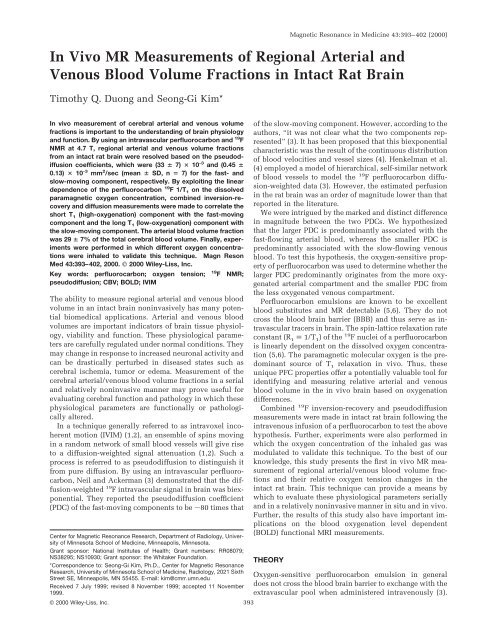



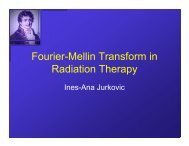
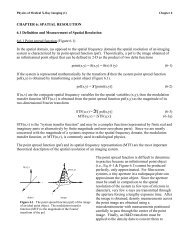
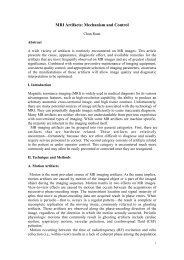
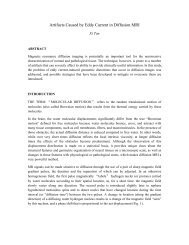
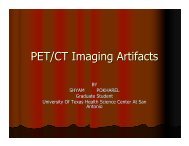
![Methods for preventing Motion Artifacts in MRI [pdf]](https://img.yumpu.com/28806288/1/190x146/methods-for-preventing-motion-artifacts-in-mri-pdf.jpg?quality=85)
